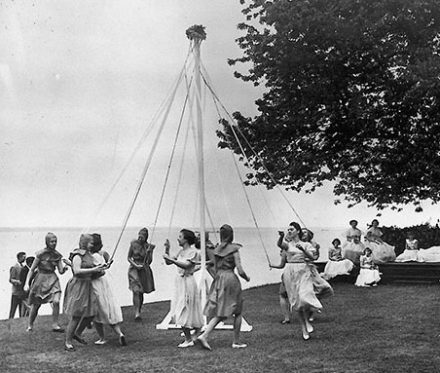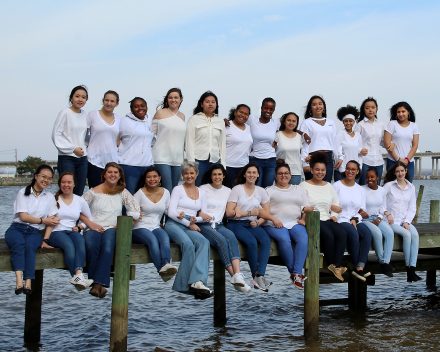
In 1923, students at St. Margaret’s join in the
school’s annual Maypole Dance.
The year was 1920 and the country was reeling from the aftershock of World War I. Americans felt an urgent need to restore humanity and renew their commitment to social causes. For the Diocese of Virginia, much of that energy was channeled into building religious schools that would provide a good education in a Christian environment where young people could grow into servant leaders for their communities.
“Back then, there weren’t a lot of schools of any kind,” says David Charlton, President of the Church Schools. Urban schools were overcrowded and rural areas had only a few schools spanning vast distances.
The Church Schools in the Diocese of Virginia was incorporated on June 8, 1920 with three goals in mind: to purchase existing schools that needed financial support, to build new schools to serve more students, and to provide scholarships for the growing number of orphaned children.
In its founding year, Church Schools purchased three underfunded schools – St. Anne’s School in Charlottesville and the renamed St. Catherine’s School and St. Christopher’s School in Richmond. In the same year, the group turned its attention to the underserved Tidewater region, where they established St. Margaret’s School for girls in Tappahannock and Christchurch School for boys in Middlesex County near the Town of Urbanna. Both schools began operations in September of 1921.

The St. Margaret’s class of 2019.
St. Margaret’s opened in 1921 in a room above a Tappahannock pharmacy. There were 3 boys and 13 girls in grades K-11.
The following year, the students moved to the “Wright property,” a house purchased by the Church Schools. The tuition for the 1922 session was $500. By 1931, St. Margaret’s was home to 70 boarders and 20 days students. Since 1940, the school has purchased adjacent properties and built new buildings to foster steady growth. Today, St. Margaret’s is home to 110 students in who hail from across the US and 8 other countries. The school serves girls in grades 8-12, with about 70% boarding and 30% day students.
St. Margaret’s 12th Head of School, Cathy Sgroi, began at the school as a math teacher and has worked at St. Margaret’s for 45 years. “The one thing that has not changed
about St. Margaret’s School is its mission,” says Sgroi. “St. Margaret’s School provides a learning environment where girls know they belong, are challenged and supported to believe in themselves, and prepared to become their best. We inspire girls to reach their full potential and make a better world. I believe our mission is more relevant than ever because young women face more challenges than ever.”

Christchurch students in the 1950s enjoyed
basketball games in Marston Hall, which is now the David & Wendy Charlton Fine and Performing Arts Center.
Thirty miles down the road from St. Margaret’s, Christchurch School opened in a hastily converted farmhouse on the 108-acre Eastman Farm near Urbanna. Ten students, all boys, came primarily from cities and towns
across Virginia. Within the first six months, the farmhouse was enlarged, remodeled and fitted with modern improvements. Today, Christchurch serves families from 15 different states and 14 different countries.
“The enduring spirit of Christchurch is that when you arrive you are welcomed, you belong, and you are loved,” says the current Head of School Jeb Byers who has served the school for over thirty years. “There are no rites of passage. We are one. From day one. We meet you where you are and we go as far as we can imagine. Together. Relationships make meaning: this is our core belief.”
By 1944, population growth in Northern Virginia had brought so many students to Alexandria’s St. Agnes’ School, founded in 1924, that the facilities were bursting at the seams. In desperate need of space – and a supporter who could fund it – the headmistress and chairwoman of St. Agnes’ asked to join the Church Schools.
At the same time that the Church Schools brought St. Agnes into the fold, the leaders were also working on plans to establish a boys’ school in Alexandria. This would allow St. Agnes’ to transfer its older male students to the new school and further alleviate the crowded quarters. St. Stephen’s opened in 1944 with roughly 100 boys in grades 3-8.
St. Stephen’s became the first of the Church Schools to desegregate its student body, admitting its first African American student in 1961. Over the next decade, the each of the other schools in the Church Schools system admitted their first African Americans students, while most Virginia public schools continued to fight racial integration in the courts. The total Church Schools enrollment in academic year 2019-20 was 3,690 students of which almost 24% were persons of color, with a range of 14% to 43%, depending on the individual school.

On the steps of John C Scott dormitory, Christchurch students soak up the sunshine and breeze coming off the river. .
As schools were being bought or built by the Church Schools, one school departed the group. In 1970, St. Anne’s merged with the Belfield School, a Charlottesville coeducational elementary and middle feeder school, and negotiated to become an
“associate” member of Church Schools with its own separate corporation status. In 1987, St. Anne’s-Belfield School became completely independent of Church Schools.
Changes were on the horizon in Alexandria schools as well. St. Stephen’s and St. Agnes had long coordinated their educational programs, providing opportunities for coeducation. In the mid 1980’s, St. Stephen’s proposed that it become a coeducational institution. After years of negotiation and litigation, the two nearby schools merged in 1991, becoming one coed school named St. Stephen’s and St. Agnes School. During the same years, St. Catherine’s and St. Christopher’s seriously considered a similar merger, but decided in 1991 to retain their own separate identities while expanding their cooperative educational programs.
Stuart Hall, Staunton, is the newest addition of the Church Schools system. Originally founded in 1844 as the Virginia Female Institute, Stuart Hall had a long history as an Episcopal school tied to all three Virginia dioceses. Desiring the benefits of belonging to the system of Church Schools, it was admitted to that system in 2003. Stuart Hall had expanded into coeducation in the 1990s, and in 2007 expanded into elementary education through a merger with Hunter McGuire Elementary School, Verona.
Today, the Church Schools owns six schools that are an integral part of the diocesan family. Between the Church Schools, 179 churches, six diocesan retirement communities, and the retreat centers of Shrine Mont and Roslyn, the Diocese cares for God’s children in every season of life. The formation of faithful servants of Christ is a diocesan ministry that spans the generations.
Dr. Charlton says that while just about every aspect of education has changed since the founding of the Church Schools 100 years ago, one thing will always remain unchanged. “The founders believed that religious education was important to make the Commonwealth and the world a better place by building good human beings.” Looking to the future, he says, “We’ll adapt however we need to keep doing that.”
Recalling her own experience working in the Church Schools, Bishop Susan Goff says, “I join in celebrating 100 years of commitment to education through our Church Schools. Having served as chaplain of St. Margaret’s and later of St. Catherine’s, I have experienced first hand the good work of our schools and the challenges they face as they begin their second hundred years. God bless the six schools that are part of Church Schools in the Diocese of Virginia with a commitment to justice, integrity and faith.”